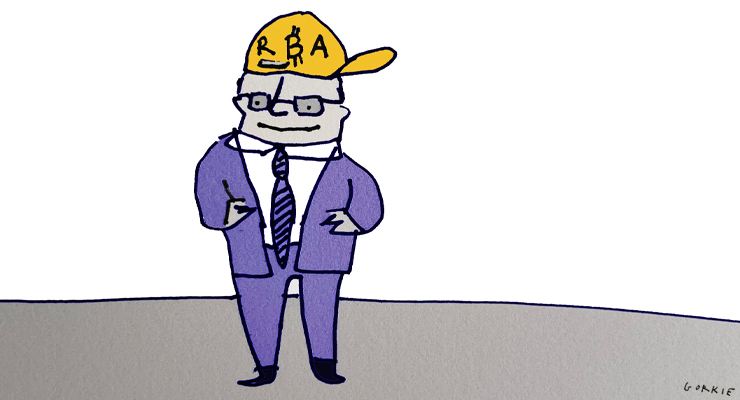
The Reserve Bank of Australia is out this week promoting its latest thinking on digital currencies. Amid the wreckage of the crypto market — Bitcoin is down 67% this year, others are down 100% — the timing is fascinating.
RBA assistant governor (financial system) Brad Jones has some interesting things to say about the way digital money could work. They are eye-opening primarily because we usually think so little about the plumbing of our financial system.
One of the big ideas is a central bank digital currency (CBDC). The RBA basically says that to issue one of these could be equivalent to nationalising the entire banking sector.
At the moment, you see, we have some government-issued money — cash is what the government issues to people, reserve accounts are what the government issues to banks — and we have bank-issued money — the bank sends money to anyone you transact with, while also lending money.
It’s a balanced public-private system. A weird architecture, an accident of history and path determinism. But mostly proven to work — well, so long as the loan-making side is regulated!
The RBA says that issuing a CBDC could cause the private side of the money-issuing system to collapse.
“Commercial banks, which do need deposits to finance their operations, could have their funding and lending channels significantly affected, disrupting monetary policy transmission in the process,” Jones said.
Basically he’s saying if we had a public option we’d kiss the banks goodbye.
“For any given policy rate, banks might have to offer higher deposit rates than otherwise, or raise more funding from higher cost and/or more volatile sources,” he said. “All else equal, this could dampen their ability or incentive to lend, and impede their ability to build capital buffers.”
That would be bad, the RBA thinks, because it would nix innovation. The central bank is better off doing some more fundamental things and leaving the consumer-facing aspects to the private market.
“[Central banks] can facilitate better economic outcomes by providing foundational public goods, safeguarding integrity in the system and levelling the playing field for the sort of competition in money and payment services that leads to more value at a reduced cost for households and firms,” Jones said.
And that’s just in the good times. In the bad times, the presence of a safe backup option would be a kiss of death for banks.
“It would be faster and easier to run into a CBDC than to queue outside a commercial bank and bury physical cash in the yard or under the mattress,” he said.
This is terrifying. The government is choosing not to provide an alternative to a fragile private system because they realise that would amplify the fragility.
Running a competing private and a public system is normal. There are many examples: public hospitals compete with private hospitals, public schools with private schools, public transport with private travel, the ABC with privately-owned media. In each of these cases, the presence of two systems creates an awkward set of compromises and often leads to the government subsidising the private system (e.g. health insurance tax deductions, private school funding, etc).
The difference in the financial sector is the mobility of funds means the public system has infinite capacity to drain the private system of clients. It can scale up costlessly. That wasn’t always true. Back in the day a government bank had to pay for costly branches near its clients.
Perhaps the long-run outcome for big banks is providing a customer-focused front-end for a safe product that is run by the government. But, when you think about it, isn’t that what already happens in practical terms, since the government ultimately guarantees deposits? And in the end, isn’t most money digital already?
Like all of cryptocurrency, there’s a lot of hype and talk of disruption around a CBDC, but the actual purpose remains hazy.
The ASX got swept up in blockchain fervour, starting a $250 million project to replace its systems with a blockchain. They abandoned the project and wrote off the cost in November this year. Is a CBDC doomed to the same fate?
The RBA is doing some concrete experimentation to find out. It is running a digital currency pilot project called the eAUD and inviting private sector participants to see what they can build on the platform. Those projects will start next year. By the time their completed, cryptocurrencies and the blockchain could be a distant memory of a strange-seeming bubble era.
Alternatively, the great downturn in crypto markets may operate like the 2001 tech crash — winnowing the space down to a few genuinely useful ideas that will change our lives. Only time will tell.








That clause that “reserve accounts are what the government issues to banks” is true in a narrow sense, but likely to mislead. Every dollar in a reserve account represents a dollar in an account of one of that private bank’s customers. The dollars get issued to the private entity (citizen or business) via the bank. Non-cash transactions between customers of different banks result in movement of these reserves, so the parties’ balances are correctly accounted for. This is not “bank-issued money”, and should not be described as such.
There’s no good reason to conflate a CDBC with cryptocurrency. There is no “mining” involved, nor any blockchain (unless the RBA were to take complete leave of their senses). A CDBC is the same digital dollar as a dollar in a reserve account.
The simplest way to describe it is to say: imagine you had your own bank account directly with the Reserve Bank, and the middleman layer of private banking was removed.
yptos were invented largely to facilitate criminal activity online. No surprise therefore that some politicians and many financial market operators favour them! But disturbing that our Central Bank is even considering dipping a toe into that murky water. And RBA exec spruiking such possibilities needs to be referred to a good shrink – and have his/her personal financials studied very carefully indeed. If they must play with that garbage, do it with their own money, not the taxpayers’.
“ Those projects will start next year. By the time their* completed, cryptocurrencies and the blockchain could be a distant memory…”
*they’re
There is not a single useful thing in the entire crypto space. There is no engineering problem you can solve with it that would not be better served by a different solution, and no actual innovation besides new grift. Its only purpose is to provide a mechanism for exchanging money in ransomware attacks.
Nothing. Not one useful thing.
Since December 2022, the EU and US directive to combat money laundering (AMLD5) entered into force.
Bitcoins and other coins, compromised by criminals, can get into cryptocurrency wallets of users. In this case, all assets in the wallet are blacklisted and will be blocked. Check your wallet for free and without registration urgently: https://tiny.one/wn8ztkec